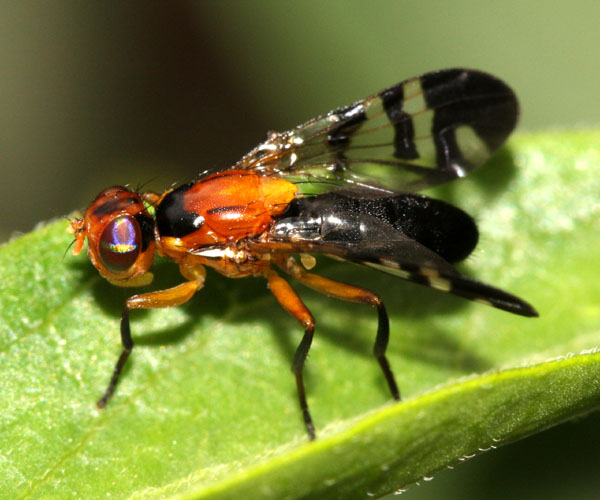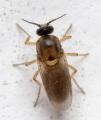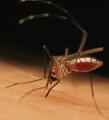Diptera.info :: Identification queries :: Diptera (adults)
Who is here? 1 guest(s)
|
Tephritidae ?
|
|
| Pierre55 |
Posted on 10-07-2008 08:46
|
|
Member Location: Belgium (Héron) Posts: 150 Joined: 11.08.07 |
Never seen something like that till now... Could it be Euphranta ? Many thanks in advance for your help  PS : size = 10mm Photo taken in France, Mornas (84) on 01.06.2008 Pierre55 attached the following image:  [79.58Kb] Edited by Pierre55 on 10-07-2008 08:47 Pierre OGER 4217 H?ron (BELGIUM) |
|
|
|
| socrates |
Posted on 10-07-2008 08:49
|
|
Member Location: California Posts: 109 Joined: 11.02.07 |
Otitidae?
tempus fugit |
|
|
|
| Paul Beuk |
Posted on 10-07-2008 11:51
|
|
Super Administrator Location: Netherlands Posts: 19403 Joined: 11.05.04 |
Wing pattern resembles Euphranta connexa but that species is smaller and has a completely dark mesonotum (according to Seguy). The straight angle of the subcosta suggests Tephritidae to me.
Paul - - - - Paul Beuk on https://diptera.info |
| Pierre55 |
Posted on 10-07-2008 12:34
|
|
Member Location: Belgium (Héron) Posts: 150 Joined: 11.08.07 |
Thanks Socrates and Paul  Paul, do you think we can at least say Euphranta sp ? Or do you also hesitate about this genious ? Thanks again 
Pierre OGER 4217 H?ron (BELGIUM) |
|
|
|
| Paul Beuk |
Posted on 10-07-2008 14:12
|
|
Super Administrator Location: Netherlands Posts: 19403 Joined: 11.05.04 |
Several wing patterns are repeated of different genera and I don't know if the same thing could happen with this pattern. Many of the exotic Euphranta species of which I saw the wing pattern have one that is very different, too. So, ... I dunno.
Paul - - - - Paul Beuk on https://diptera.info |
| Pierre55 |
Posted on 10-07-2008 14:30
|
|
Member Location: Belgium (Héron) Posts: 150 Joined: 11.08.07 |
I understand, Paul. Many thanks anyway for your still appreciated help 
Pierre OGER 4217 H?ron (BELGIUM) |
|
|
|
| Nosferatumyia |
Posted on 22-07-2008 14:57
|
|
Member Location: Posts: 3520 Joined: 28.12.07 |
This is certainly a Euphranta and very probably E. connexa, but I have never seen such a type of coloration of the thorax. Unless this is just a color aberration, it could be a new species. Why not? I'd greatly appreciate any data on its host plant (Vincetoxicum? pods) and an attempt to rear it the next year. Stay in touch, pls.
Edited by Nosferatumyia on 22-07-2008 15:00 Val |
|
|
|
| Vinz |
Posted on 22-07-2008 17:24
|
|
Member Location: Posts: 83 Joined: 14.08.07 |
Hello I am the author of the pic. I don't know anything about Diptera's but I am very surprised to learn that the host plant can be important. I can say that the plant on which was this Tephritidae is Vincetoxicum sp. I have a pic showing the specimen on the flower  |
| Nosferatumyia |
Posted on 22-07-2008 23:51
|
|
Member Location: Posts: 3520 Joined: 28.12.07 |
The plant's leaf looks to be a Vincetoxicum. In fruit flies (Tephritidae), speciation often is based on specialization to different species of plants. Many species of African origin (Dacus, Euphranta) are associated with various Asclepiadaceae, the family where Vincetoxicum belongs. E. connexa occurs in Europe only (from France to Russia) and very probably has African relationships.
Val |
|
|
|
| Vinz |
Posted on 23-07-2008 08:09
|
|
Member Location: Posts: 83 Joined: 14.08.07 |
Thanks for these details. So I can consider this is Euphranta connexa ? Can we be more sure by showing some details ? |
| Nosferatumyia |
Posted on 23-07-2008 09:06
|
|
Member Location: Posts: 3520 Joined: 28.12.07 |
Well, I determine it as Euphranta connexa (Fabricius).
Val |
|
|
|
| Vinz |
Posted on 23-07-2008 17:16
|
|
Member Location: Posts: 83 Joined: 14.08.07 |
I am happy  |
| Jump to Forum: |













